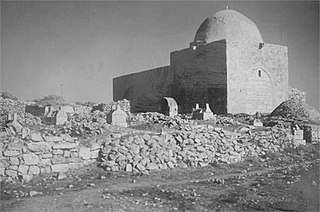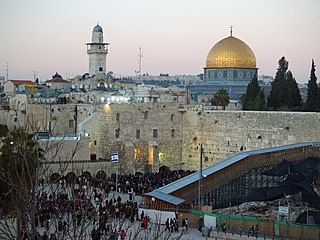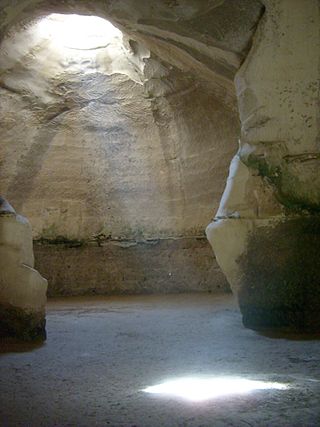Related Research Articles

The Cave of the Patriarchs or Tomb of the Patriarchs, known to Jews by its Biblical name Cave of Machpelah and to Muslims as the IbrahimiMosque, is a series of caves situated 30 kilometres (19 mi) south of Jerusalem in the heart of the Old City of Hebron in the West Bank. According to the Abrahamic religions, the cave and adjoining field were purchased by Abraham as a burial plot, although most historians believe the Abraham-Isaac-Jacob narrative to be primarily mythological.

An ossuary is a chest, box, building, well, or site made to serve as the final resting place of human skeletal remains. They are frequently used where burial space is scarce. A body is first buried in a temporary grave, then after some years the skeletal remains are removed and placed in an ossuary. The greatly reduced space taken up by an ossuary means that it is possible to store the remains of many more people in a single tomb than in coffins.

Mount Carmel, also known in Arabic as Mount Mar Elias, is a coastal mountain range in northern Israel stretching from the Mediterranean Sea towards the southeast. The range is a UNESCO biosphere reserve. A number of towns are situated there, most notably the city of Haifa, Israel's third largest city, located on the northern and western slopes.

Rachel's Tomb is a site revered as the burial place of the Biblical matriarch Rachel. The site is also referred to as the Bilal bin Rabah mosque. The tomb is held in esteem by Jews, Christians, and Muslims. The tomb, located at the northern entrance to the Palestinian city of Bethlehem, next to the Rachel's Tomb checkpoint, is built in the style of a traditional maqam, Arabic for shrine.

The archaeology of Israel is the study of the archaeology of the present-day Israel, stretching from prehistory through three millennia of documented history. The ancient Land of Israel was a geographical bridge between the political and cultural centers of Mesopotamia and Egypt. Despite the importance of the country to three major religions, serious archaeological research only began in the 15th century. Although he never travelled to the Levant, or even left the Netherlands, the first major work on the antiquities of Israel is considered to be Adriaan Reland's Antiquitates Sacrae veterum Hebraeorum, published in 1708. Edward Robinson, an American theologian who visited the country in 1838, published its first topographical studies. Lady Hester Stanhope performed the first modern excavation at Ashkelon in 1815. A Frenchman, Louis Felicien de Saucy, embarked on early "modern" excavations in 1850. Today, in Israel, there are some 30,000 sites of antiquity, the vast majority of which have never been excavated.

Atlit Yam is an ancient submerged Neolithic village off the coast of Atlit, Israel. It has been carbon-dated as to be between 8,900 and 8,300 years old. Among the features of the 10-acre site is a stone circle.

The Atlit detainee camp was a concentration camp established by the authorities of Mandatory Palestine in the late 1930s on what is now the Israeli coastal plain, 20 kilometres (12 mi) south of Haifa. Under British rule, it was primarily used to hold Jews and Arabs who were in administrative detention; it largely held Jewish immigrants who did not possess official entry permits. Tens of thousands of Jewish refugees were interned at the camp, which was surrounded by barbed wire and watchtowers.

Ben Shemen is a moshav in central Israel. Located around four kilometres east of Lod, it falls under the jurisdiction of Hevel Modi'in Regional Council. In 2021 it had a population of 876.

Tourism in Israel is one of Israel's major sources of income, with a record 4.55 million tourist arrivals in 2019, and, in 2017, contributed NIS 20 billion to the Israeli economy making it an all-time record. Israel offers a plethora of historical and religious sites, beach resorts, natural sites, archaeological tourism, heritage tourism, adventure tourism, and ecotourism. Israel has the highest number of museums per capita in the world. For practical reasons, this article also covers tourism in the Israeli-occupied West Bank and the occupied Golan Heights, since it is closely interconnected with the mass tourism in Israel.

Ohel is a structure built around a Jewish grave as a sign of prominence of the deceased. Ohelim cover the graves of some Hasidic Rebbes, important rabbis, tzadikim, prominent Jewish community leaders, and biblical figures. Typically a small masonry building, an ohel may include room for visitors to pray, meditate, and light candles in honor of the deceased.

Es-Skhul or the Skhul Cave is a prehistoric cave site situated about 20 kilometres south of the city of Haifa, Israel, and about 3 km (1.9 mi) from the Mediterranean Sea.

Beit She'arim necropolis is an extensive necropolis of rock-cut tombs near the remains of the ancient Jewish town of Beit She'arim. In early modern times the site was the Palestinian village of Sheikh Bureik; it was depopulated in the 1920s as a result of the Sursock Purchases, and identified as Beit She'arim in 1936 by historical geographer Samuel Klein.
The Fire Mummies of the Philippines, also known as the Kabayan Mummies, Benguet Mummies, or Ibaloi Mummies, are a group of mummies found along the mountain slopes of Kabayan, a town in the northern part of the Philippines. They were made from as early as 2000 BCE. Today, they remain in natural caves and a museum in Kabayan.

Beit Guvrin-Maresha National Park is a national park in central Israel, containing a large network of caves recognized by UNESCO as a World Heritage Site. The national park includes the remains of the historical towns of Maresha, one of the important towns of Judah during the First Temple Period, and Bayt Jibrin, a depopulated Palestinian town known as Eleutheropolis in the Roman era. However, Maresha and Bayt Jibrin are not part of the UNESCO site, which covers only the cave network.

Qesem cave is a Lower Paleolithic archaeological site near the city of Kafr Qasim in Israel. Early humans were occupying the site by 400,000 until c. 200,000 years ago.

Qumran Caves are a series of caves, both natural and artificial, found around the archaeological site of Qumran in the Judaean Desert. It is in these caves that the Dead Sea Scrolls were discovered.

Jason's Tomb is a rock-cut tomb dating to the first century BCE in the Hasmonean period, discovered in the Rehavia neighborhood in Jerusalem, Israel. It has been identified as the burial site of a certain Jason, possibly a naval commander, based on the charcoal drawing of two warships discovered in the cave.
Avi Gopher is an Israeli archaeologist. He is a professor at the University of Tel Aviv.

The Caves of Nahal Me’arot / Wadi el-Mughara, named here by the Hebrew and Arabic name of the valley where they are located, are a UNESCO Site of Human Evolution in the Carmel mountain range near Haifa in northern Israel.

The politics of archaeology in Israel and Palestine refers to the significance of archaeology in the politics and social fabric of Israel and Palestine. Many important developments in Levantine archaeology have occurred within Israel and Palestine.
References
- ↑ "Israel to include West Bank shrines in heritage plan". Reuters. 2010-02-22.
- ↑ AP (2010-02-25). "US slams Israel over designating heritage sites". Haaretz. Retrieved 2011-09-07.